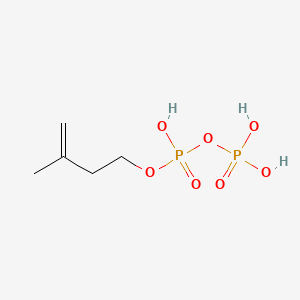| MeSH term | MeSH ID | Detail |
|---|---|---|
| Melanoma | D008545 | 69 associated lipids |
Isopentenyl pyrophosphate
Isopentenyl pyrophosphate is a lipid of Prenol Lipids (PR) class. Isopentenyl pyrophosphate is associated with abnormalities such as Tuberculosis, NAVAJO NEUROHEPATOPATHY and Cryptosporidiosis. The involved functions are known as Signal, Anabolism, T-Cell Activation, T-Cell Proliferation and isoprenoid biosynthetic process. Isopentenyl pyrophosphate often locates in Protoplasm, Host Cell, soluble, Plastids and Cell surface. The associated genes with Isopentenyl pyrophosphate are oxytocin, 1-desamino-(O-Et-Tyr)(2)-, HLA-E gene, RAP1A gene, Gene Family and Orthologous Gene. The related lipids are Steroids, Sterols and isopentenol.
Cross Reference
Introduction
To understand associated biological information of Isopentenyl pyrophosphate, we collected biological information of abnormalities, associated pathways, cellular/molecular locations, biological functions, related genes/proteins, lipids and common seen animal/experimental models with organized paragraphs from literatures.
What diseases are associated with Isopentenyl pyrophosphate?
Isopentenyl pyrophosphate is suspected in Tuberculosis, NAVAJO NEUROHEPATOPATHY, Cryptosporidiosis and other diseases in descending order of the highest number of associated sentences.
Related references are mostly published in these journals:
| Disease | Cross reference | Weighted score | Related literature |
|---|
Possible diseases from mapped MeSH terms on references
We collected disease MeSH terms mapped to the references associated with Isopentenyl pyrophosphate
PubChem Associated disorders and diseases
What pathways are associated with Isopentenyl pyrophosphate
Lipid pathways are not clear in current pathway databases. We organized associated pathways with Isopentenyl pyrophosphate through full-text articles, including metabolic pathways or pathways of biological mechanisms.
Related references are published most in these journals:
| Pathway name | Related literatures |
|---|
PubChem Biomolecular Interactions and Pathways
Link to PubChem Biomolecular Interactions and PathwaysWhat cellular locations are associated with Isopentenyl pyrophosphate?
Visualization in cellular structure
Associated locations are in red color. Not associated locations are in black.
Related references are published most in these journals:
| Location | Cross reference | Weighted score | Related literatures |
|---|
What functions are associated with Isopentenyl pyrophosphate?
Related references are published most in these journals:
| Function | Cross reference | Weighted score | Related literatures |
|---|
What lipids are associated with Isopentenyl pyrophosphate?
Related references are published most in these journals:
| Lipid concept | Cross reference | Weighted score | Related literatures |
|---|
What genes are associated with Isopentenyl pyrophosphate?
Related references are published most in these journals:
| Gene | Cross reference | Weighted score | Related literatures |
|---|
What common seen animal models are associated with Isopentenyl pyrophosphate?
There are no associated biomedical information in the current reference collection.
NCBI Entrez Crosslinks
All references with Isopentenyl pyrophosphate
Download all related citations| Authors | Title | Published | Journal | PubMed Link |
|---|---|---|---|---|
| Dong L et al. | Monoterpene biosynthesis potential of plant subcellular compartments. | 2016 | New Phytol. | pmid:26356766 |
| Quinzii CM et al. | Human coenzyme Q10 deficiency. | 2007 Apr-May | Neurochem. Res. | pmid:17094036 |
| Gilg AB et al. | Unique animal prenyltransferase with monoterpene synthase activity. | 2009 | Naturwissenschaften | pmid:19277597 |
| Tanaka Y et al. | Natural and synthetic non-peptide antigens recognized by human gamma delta T cells. | 1995 | Nature | pmid:7753173 |
| Ralph SA et al. | Tropical infectious diseases: metabolic maps and functions of the Plasmodium falciparum apicoplast. | 2004 | Nat. Rev. Microbiol. | pmid:15083156 |
| Vavassori S et al. | Butyrophilin 3A1 binds phosphorylated antigens and stimulates human γδ T cells. | 2013 | Nat. Immunol. | pmid:23872678 |
| Kuzuyama T and Seto H | Diversity of the biosynthesis of the isoprene units. | 2003 | Nat Prod Rep | pmid:12735695 |
| Banerjee A and Sharkey TD | Methylerythritol 4-phosphate (MEP) pathway metabolic regulation. | 2014 | Nat Prod Rep | pmid:24921065 |
| Ganjewala D and Luthra R | Essential oil biosynthesis and regulation in the genus Cymbopogon. | 2010 | Nat Prod Commun | pmid:20184044 |
| Radakovits R et al. | Draft genome sequence and genetic transformation of the oleaginous alga Nannochloropis gaditana. | 2012 | Nat Commun | pmid:22353717 |
| Chou HH and Keasling JD | Programming adaptive control to evolve increased metabolite production. | 2013 | Nat Commun | pmid:24131951 |
| Peralta-Yahya PP et al. | Identification and microbial production of a terpene-based advanced biofuel. | 2011 | Nat Commun | pmid:21952217 |
| Span I et al. | Discovery of acetylene hydratase activity of the iron-sulphur protein IspH. | 2012 | Nat Commun | pmid:22948824 |
| Ling S et al. | Genoprotective pathways. II. Attenuation of oxidative DNA damage by isopentenyl diphosphate. | 2004 | Mutat. Res. | pmid:15450402 |
| Zhang X et al. | Functional Analysis of the Isopentenyl Diphosphate Isomerase of Salvia miltiorrhiza via Color Complementation and RNA Interference. | 2015 | Molecules | pmid:26569204 |
| Gajjar D et al. | Quantification of dolichol in the human lens with different types of cataracts. | 2009 | Mol. Vis. | pmid:19693292 |
| Kim J et al. | Three serendipitous pathways in E. coli can bypass a block in pyridoxal-5'-phosphate synthesis. | 2010 | Mol. Syst. Biol. | pmid:21119630 |
| Plata G et al. | Reconstruction and flux-balance analysis of the Plasmodium falciparum metabolic network. | 2010 | Mol. Syst. Biol. | pmid:20823846 |
| Forster AC and Church GM | Towards synthesis of a minimal cell. | 2006 | Mol. Syst. Biol. | pmid:16924266 |
| Haussig JM et al. | Inactivation of a Plasmodium apicoplast protein attenuates formation of liver merozoites. | 2011 | Mol. Microbiol. | pmid:21848587 |
